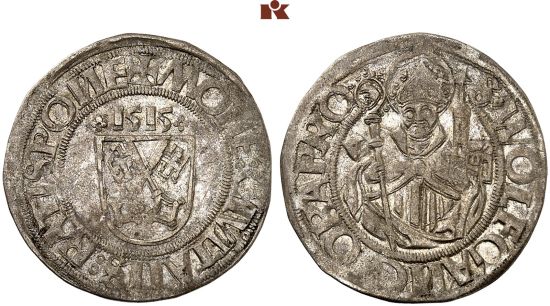Difference between revisions of "Regensburg 1515 1/2 batzen"
m (Text replacement - "Beckenb." to "Beckenbauer") |
m (Text replacement - "(Osnabruck" to "(Osnabrück") |
||
| Line 1: | Line 1: | ||
[[Image:K405-3015.jpg|550px|thumb|Künker sale 405, lot 3015]] | [[Image:K405-3015.jpg|550px|thumb|Künker sale 405, lot 3015]] | ||
| − | This specimen was lot 3015 in Künker sale 405 ( | + | This specimen was lot 3015 in Künker sale 405 (Osnabrück, March 2024), where it sold for €45 (about US$59 including buyer's fees). The catalog description<sup>[1]</sup> noted, <blockquote>"''DIE REICHSSTADT REGENSBURG. DIE ZEIT DES KAISERS MAXIMILIAN I., 1508-1519. Die kleineren Nominale aus der Zeit des Kaisers Maximilian I. ½ Batzen 1515. Münzmeister Martin Lerch. Sehr schön-vorzüglich.'' ([[German States, Regensburg|city of Regensburg]], half batzen of 1515, struck in the name of Maximilian I. Very fine to extremely fine.)"</blockquote> This type was struck 1510-16. The half batzen, or two kreuzer, was a denomination best known from Switzerland. At this time, fifteen batzen made a thaler or gulden. The reverse depicts St. Wolfgang, with a legend imploring, "S:WOLFGAИG:ORA PRO:", that is, "Saint Wolfgang, pray for us." The obverse states, "MOИE:CIVITAS:RATISPOИE+" = "Coin of the city of Regensburg". |
Wikipedia comments, "Wolfgang of Regensburg (c. 934-994 AD) was bishop of Regensburg in Bavaria from Christmas 972 until his death. He is regarded as one of the three great German saints of the 10th century, the other two being Ulrich of Augsburg and Conrad of Constance. Soon after Wolfgang's death many churches chose him as their patron saint, and various towns were named after him." | Wikipedia comments, "Wolfgang of Regensburg (c. 934-994 AD) was bishop of Regensburg in Bavaria from Christmas 972 until his death. He is regarded as one of the three great German saints of the 10th century, the other two being Ulrich of Augsburg and Conrad of Constance. Soon after Wolfgang's death many churches chose him as their patron saint, and various towns were named after him." | ||
Latest revision as of 20:11, 1 December 2024
This specimen was lot 3015 in Künker sale 405 (Osnabrück, March 2024), where it sold for €45 (about US$59 including buyer's fees). The catalog description[1] noted,
"DIE REICHSSTADT REGENSBURG. DIE ZEIT DES KAISERS MAXIMILIAN I., 1508-1519. Die kleineren Nominale aus der Zeit des Kaisers Maximilian I. ½ Batzen 1515. Münzmeister Martin Lerch. Sehr schön-vorzüglich. (city of Regensburg, half batzen of 1515, struck in the name of Maximilian I. Very fine to extremely fine.)"
This type was struck 1510-16. The half batzen, or two kreuzer, was a denomination best known from Switzerland. At this time, fifteen batzen made a thaler or gulden. The reverse depicts St. Wolfgang, with a legend imploring, "S:WOLFGAИG:ORA PRO:", that is, "Saint Wolfgang, pray for us." The obverse states, "MOИE:CIVITAS:RATISPOИE+" = "Coin of the city of Regensburg".
Wikipedia comments, "Wolfgang of Regensburg (c. 934-994 AD) was bishop of Regensburg in Bavaria from Christmas 972 until his death. He is regarded as one of the three great German saints of the 10th century, the other two being Ulrich of Augsburg and Conrad of Constance. Soon after Wolfgang's death many churches chose him as their patron saint, and various towns were named after him."
Recorded mintage: unknown.
Specification: 1.96 g, 0.437 fine silver, 21-23 mm diameter, this specimen 1,89 g.
Catalog reference: KM MB9, Beckenbauer 1308; Slg. Bach (Auktion Künker 238) 4512.
- Craig, William D., Germanic Coinages: Charlemagne through Wilhelm II, Mountain View, CA: 1954.
- Nicol, N. Douglas, Cuhaj, George S., and Thomas Michael, Standard Catalog of German Coins, 1501-Present, 3rd ed., Iola, WI: Krause Publications, 2011.
- [1]Künker, Fritz Rudolf, Horst-Rudiger Künker, Ulrich Künker and Andreas Kaiser, Katalog 405: Coins of the Bishopric and City of Regensburg - A significant special collection, Osnabrück: Fritz Rudolf Künker GmbH & Co., AG, 2024.
Link to:
